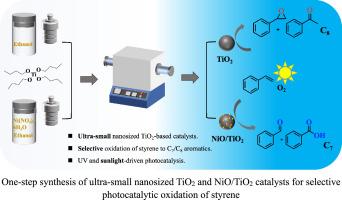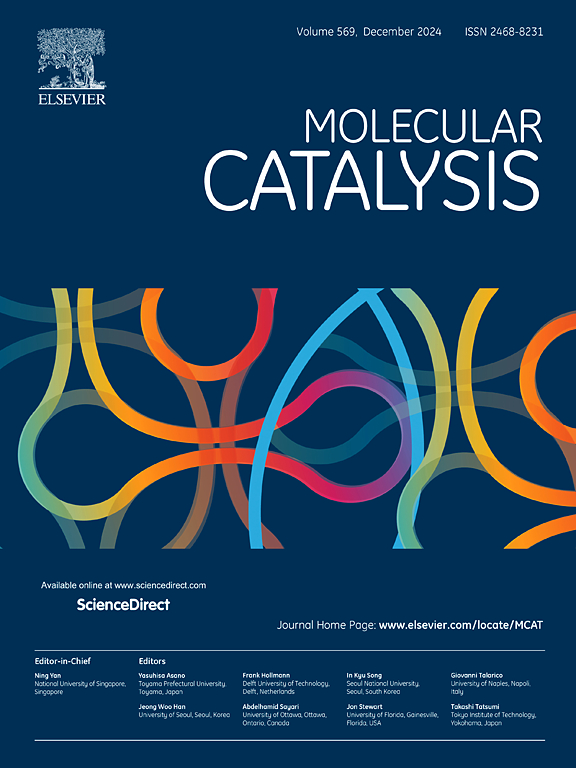利用基于 TiO2 的催化剂通过绿色光催化将苯乙烯选择性氧化为有价值的 C7 或 C8 芳烃
IF 4.9
2区 化学
Q2 CHEMISTRY, PHYSICAL
引用次数: 0
摘要
选择性氧化苯乙烯侧链以生成高附加值的 C7 或 C8 芳香族化合物是化学工业中的一个重要反应。然而,实现对产品形成选择性的精确控制是一项重大挑战。在本研究中,我们通过一种温和、环保的光催化方法,展示了超小型纳米二氧化钛催化剂在促进苯乙烯选择性氧化方面的有效性。用 0.4% 的氧化镍改性后,产品选择性发生了显著变化。在紫外线甚至阳光型激发下,主要产物从选择性为 96% 的 C8 转变为选择性为 92% 的 C7。详细的结构和电子分析表明,在二氧化钛表面掺入氧化镍会诱导形成 P-N 异质结和额外的活性位点,这对促进 C-C 裂解至关重要,从而导致产物选择性从 C8 转变为 C7。这项研究为设计能够在苯乙烯氧化过程中实现高选择性的基于二氧化钛的简单催化剂提供了宝贵的见解,凸显了绿色光催化在工业应用中的潜力。本文章由计算机程序翻译,如有差异,请以英文原文为准。

Selective oxidation of styrene to valuable C7 or C8 aromatics via green photocatalysis with TiO2-based catalysts
The selective oxidation of styrene at its side chains to yield value-added C7 or C8 aromatic compounds represents a crucial reaction within the chemical industry. However, achieving precise control over product formation selectivity poses a significant challenge. In this study, we demonstrate the effectiveness of ultra-small nanosized TiO2-based catalysts in facilitating the selective oxidation of styrene through a mild, eco-friendly photocatalytic approach. Following modification with 0.4% NiO, a notable transformation in product selectivity is observed. The primary products shift from C8 with 96% selectivity to C7 with 92% selectivity under UV, and even sunlight-type excitation. Detailed structural and electronic analyses reveal that the incorporation of NiO onto the TiO2 surface induces the formation of a P-N heterojunction and additional active sites, crucial for promoting C-C cleavage, leading to a selectivity shift from C8 to C7 products. This research provides valuable insights into the design of simple TiO2-based catalysts capable of achieving high selectivity in the oxidation of styrene, highlighting the potential of green photocatalysis in industrial applications.
求助全文
通过发布文献求助,成功后即可免费获取论文全文。
去求助
来源期刊

Molecular Catalysis
Chemical Engineering-Process Chemistry and Technology
CiteScore
6.90
自引率
10.90%
发文量
700
审稿时长
40 days
期刊介绍:
Molecular Catalysis publishes full papers that are original, rigorous, and scholarly contributions examining the molecular and atomic aspects of catalytic activation and reaction mechanisms. The fields covered are:
Heterogeneous catalysis including immobilized molecular catalysts
Homogeneous catalysis including organocatalysis, organometallic catalysis and biocatalysis
Photo- and electrochemistry
Theoretical aspects of catalysis analyzed by computational methods
 求助内容:
求助内容: 应助结果提醒方式:
应助结果提醒方式:


